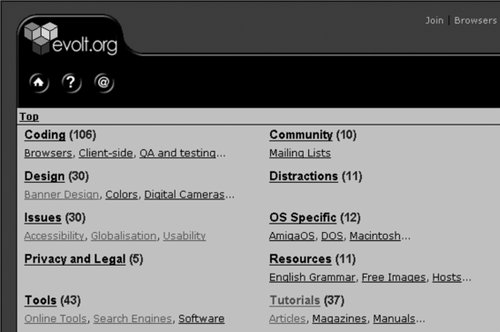Section 21.4. How Information Architecture Fits In
21.4. How Information Architecture Fits InIn this discussion of evolt.org, we haven't covered much in terms of the basic nuts and bolts of information architecture; we haven't shown a single blueprint or wireframe, or discussed how users might search and browse the site. In fact, evolt.org's information architecture is extremely simple, and perhaps not all that interesting if examined in a vacuum. However, it is extremely interesting to see how the site's information architecture enables the community to create and share contentthis, after all, is the ultimate challenge in online-community sites. The architecture's minimalism is what makes it superlative. The information architecture simply doesn't get in the way of people who wish to create content, but it does actively support getting that content in all sorts of volumes, sizes, and degrees of structure. It displays content captured elsewhereratings, comments, biographical information, and so onin new settings, such as member directory entries, and in new forms, such as cubes. It provides an open canvas for experimentation that leads to innovation. Therefore, evolt.org's information architecture has a lot to do with many of the characteristics of a successful online community. It shows how and why one might participate, provides valuable original content, helps promote a sense of ownership among its members, makes sure that contributors are recognized, and taps and repays members' philanthropy and sense of altruism. Of course, this isn't to say that evolt.org's information architecture couldn't be improved. Like any information architecture organically developed by a geographically disparate community, evolt.org's silos could be better integrated from the bottom up. And certain areas of the site haven't yet found an "economic model" to ensure their survival. 21.4.1. Cracking the Nut of Integrationevolt.org's information architecture features some major silos:
These are reasonably well integrated. For example, articles and tips link to their author's entries in the member directory; additionally, articles embed biographical content directly in the page. Tips are ingenious in that they are created specifically to be used again and again, either by being read on the fly or accessed from the tips archive. On the other hand, there are additional opportunities for further bottom-up integration. For example, the discussion-list postings don't link to their authors' entries in the member directory, and vice versa. The discussion postings are an incredibly rich resource, but it's a bit of a hassle to find out who's responsible for them; you'd need to go to the evolt.org site, log in, and search the member directory to find out the source of that brilliant posting. Threads aren't treated as objects that can be searched or browsed. The discussion archives themselves aren't easily searchable, and it could be useful to search them all together, instead of one by one. Integration is also tricky from the top down. While the site's primary organization scheme (Join, Browsers, Lists, Tips, Members, and Directory) works well for now, it probably won't scale well as new content areas spring from the m.e.o. skunk works. 21.4.2. Fit Enough to Survive?Integration aside, the other major architectural challenge that online communities face is ensuring that each of their components has a sufficiently robust "economic model." The best example of this concern can be found in evolt.org's resource directory (Figure 21-10). Created and maintained by one person, the Directory accepts suggestions for resources to include from anyone who wishes to submit them. The obvious concern is that if not enough resources are submitted, the Directory will have limited utility. If too many are submitted, the maintainer will drown in a sea of cataloging and classification. Figure 21-10. A useful directory, but will it last? How should this problem be addressed? Typically, evolt.org would look to broaden participation by incenting other members to help manage the Directory. However, developing controlled vocabularies, identifying resources, and consistently indexing and classifying content are not easy tasks for lay people (especially volunteers) in distributed environments. Controlled vocabularies in particular require a high degree of central control, something that may not be practically (or philosophically) in accord with how evolt.org works. The Yahoo! directory faced similar challenges in 1996, but Yahoo! had ample venture capital to fund its efforts. Despite that, the Yahoo! directory's quality began to erode over time, and in fact, most people now use Yahoo! for services other than its directory. The Open Directory Project, staffed completely by volunteers, has also encountered similar scaling problems. It will be difficult for evolt.org to solve this one; online communities don't typically spawn or operate by approaches that rely on significant central control. Perhaps this would be a great place to apply user taggingfolksonomies, à la del.icio.us and Flickr. Certainly, metadata control would be sacrificed, but a more sustainable modelone in line with evolt.org's philosophywould take its place. |
EAN: 2147483647
Pages: 194
- Chapter II Information Search on the Internet: A Causal Model
- Chapter VIII Personalization Systems and Their Deployment as Web Site Interface Design Decisions
- Chapter XIV Product Catalog and Shopping Cart Effective Design
- Chapter XV Customer Trust in Online Commerce
- Chapter XVI Turning Web Surfers into Loyal Customers: Cognitive Lock-In Through Interface Design and Web Site Usability